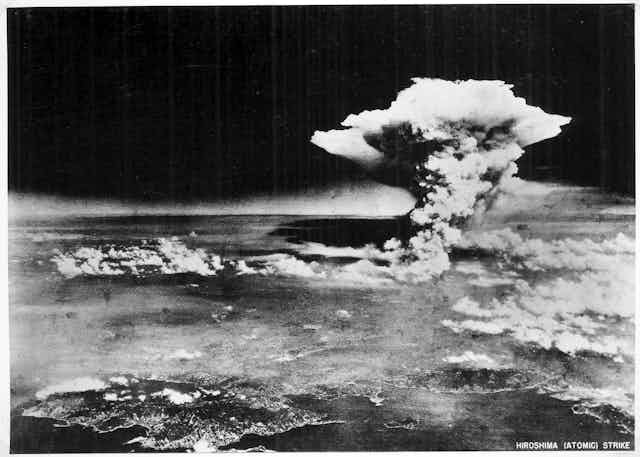On this day, August 6, seven decades ago, the United States dropped atomic bombs on the Japanese cities of Hiroshima and – on August 9 – Nagasaki. While early postwar literature registered fear of atomic warfare, there are only few references to the bomb in contemporary culture. Some argue that the bombings have sunk into the recesses of the collective unconscious.
According to Hiroshima scholar Greg Mitchell in a book he co-authored with Robert Lifton, Hiroshima in America: A Half Century of Denial (1996), the US government essentially brainwashed the public into thinking the bombings were necessary in order to win the second world war.

The Bomb was subsumed within other dominant national narratives, such as a US victory in the Pacific and anxiety over the Cold War. The controversy over whether the 50th anniversary exhibit of the Enola Gay (the B-29 plane that dropped the Hiroshima bomb) should celebrate victory or remember the fallen suggests unresolved conflict in the American psyche.
But does this alone explain why Hollywood mostly kept its distance from Hiroshima, or why contemporary novelists (aside from sci-fi authors) largely ignored the subject as a way of investigating human nature and conflict?
Mitchell tells of how US military filmmakers in the immediate aftermath of Hiroshima managed the Japanese footage. Lt.Col. (Ret.) Daniel A. McGovern kept dozens of reels until he was ordered to return to the US and turn them over to the Pentagon. Mitchell recently explained why this material was kept hidden for decades:
The main reason it was classified was […] because of the horror, the devastation.
In A Defence of Poetry (1840) Percy Shelley famously claimed that “poets are the unacknowledged legislators of the world”.

A century later in his Nobel prize acceptance speech, William Faulkner revealed a towering obstacle facing any writer up for that challenge. Faulkner cautioned the young writer against writing under fear.
Cursed with the thought of “when will I be blown up,” the young novelist, said Faulkner, must liberate him or herself from this prevailing fear in order to write about matters such as love and honour, pity and pride, that are fundamental to our humanity.
Another notable exception to this silence over Hiroshima is Kurt Vonnegut’s 1963 novel Cat’s Cradle. In this novel, Vonnegut’s narrator attempts to examine a shared responsibility over the horrific event by interviewing ordinary Americans about what they were doing on August 6, 1945. Unforgettable in that novel is the discovery of the children of one of the inventors of the A-bomb.

A major challenge facing writers who want to take on the Bomb is that conventional description fails. But in his book Nuclear Fear: A History of Images (1988), Spencer Weart demonstrates how the most enduring description of the atomic cloud as a “mushroom cloud” comes from mythology. He argues that the way we speak about and imagine nuclear weapons, and energy, is drawn from literature, emotions and medieval symbolism.
Faulkner and Vonnegut show us the importance of thinking about and communicating the unthinkable. They insist on the need to reflect on the horrors of warfare and put pressure on the way we choose to either talk or keep silent about the darkness of humanity.
But having the words to describe the event itself doesn’t always ensure an appropriate narrative. In The New Yorker, November 1946, American novelist and political activist Mary McCarthy accused journalists of referring to Hiroshima “in terms of measurable destruction”. But with Hiroshima, she argued, this cannot be done, since “the continuity of life was, for the first time, put into question”.
This sense of unparalleled calamity is registered most movingly among the Hiroshima survivors themselves. Eyewitnesses testify that it was as if everything had ceased to exist. There was nothing left.
In Dr Hachiya’s Diary of Hiroshima, memorialised in Elias Canetti’s essay collection The Conscience of Words & Earwitness (1971), the Japanese physician thinks of Pompeii. But as Canetti remarks, nature played no part in Hiroshima.

The fact that the bombing was perpetrated by humans, not nature, makes it somehow all the more inadmissible. It testifies to something unspeakable within us. But if Hiroshima and related fears aren’t explored for that reason, profound human anxieties remained unvoiced and repressed.
After all, narrative instructs us in who we are as ethical beings (citizens, in other words) and being ethical in these precarious times must involve acute self-reflection as to what we are capable of doing to each other.
As a means of communicating such profound reflection, Canetti tells us that Dr Hachiya honours the memory of the dead by pilgrimaging to the places where they lived and died, one death at a time. Hachiya does this prayerfully, Canetti writes, in order to provide a balm of respectful words. Today the Hiroshima Peace Memorial is a comparable attempt to mark an absence by paradoxically filling it with meaning.
What was rendered a blank suddenly bereft of human lives and their significance is redeemed by this doctor’s actions and by his journal. Dr Hachiya, and Canetti, bring specific individual lives back from the brink of total erasure that the bombing sought to impose.
They use words to resist this imposition of nothingness, telling a story of loss that will not fade away. May narrative continue to flourish in these precarious times.

